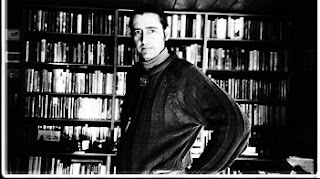I still don't think there's been anything in horror quite like
Kathe Koja's debut novel,
The Cipher (Feb 1991, Dell/Abyss). These days she writes only young-adult fiction, but close to 20 years ago she was, as far as I was concerned at the time, the absolute cutting edge of horror.
The Cipher won the Bram Stoker Award for Best First Novel (shared with Melanie Tem's excellent
Prodigal), and it also launched
Dell Publishing's Abyss line of innovative horror fiction. As their mission statement went, printed on the inner flap of each of its titles, Dell/Abyss dispensed with "haunted houses, evil children and Indian burial grounds." They wanted to present a new breed of horror novel, one that tried to get at a more real, more human, more, if you will,
illuminating darkness. Very much a reaction against the bestseller coziness of King, Koontz, Saul, and V.C. Andrews, Abyss published (mostly) unknown young writers who were literate, underground, cool, and defiantly horror.
Well, Dell/Abyss couldn't have picked a more perfect work to kick off a new darker, artier style of horror fiction than
The Cipher. The cover image (by illustrator
Marshall Arisman) is reminiscent of
Francis Bacon, and Koja's clipped, unpolished, impressionistic prose evokes surrealist, avant-garde icons like William S. Burroughs or J.G. Ballard. All of this sets a jittery, jagged tone of bleakness and rot. Her 20-something characters are poverty-gagged "artists" who exist in that demimonde of shitty jobs, squalid art galleries, and thrift stores; her settings are run-down studios, flat-beer bars, and dingy urban streets choked with black snow. Long way from Castle Rock, Dunwich, or Stepford, that's for sure.
 The Cipher
The Cipher is about literally that. Nicholas and Nakota, an unloving, dysfunctional young couple, find, in a disused storage closet of Nicholas's decrepit apartment building, a hole in the floor. A hole. Into nothing. And maybe it is
nothing.
Black. Not darkness, not the absence of light but living black. Maybe a foot in diameter, maybe a little more. Pure black and the sense of pulsation, especially when you looked at it too closely, the sense of something not living but alive, not even something but some - process. Rabbithole, some strange motherfucking wonderland, you bet...
They dub it "the Funhole" (Koja's original title for the novel) but it is anything but fun; it is a locus of obsession and transformation. Nakota, conniving, manipulative, angular, and demanding, constantly pressures Nicholas to fuck with the Funhole, to test their limits. First, a jar of insects goes down into it; then a mouse. All come back monstrously deformed and mostly dead. Finally they lower down a camcorder (a funny dated bit is how difficult it is for them to actually
get a camcorder) and when they watch the recording they see
something like bloody stalks, caressing the screen like hands behind the glass, a figure carving itself...

And this home movie that Nakota can't stop watching (
"You're watching that like porno"), and Nicholas accidentally gets his hand in there, and now there's a weeping seeping cipher in his
hand, and his empty, aimless life is going down, down, down... Until the local art-world poseurs get wind of something strange going on through Nakota, and start haranguing Nicholas to show them what he's doing, what's he got in there, can we see too? They all find out, because the Funhole is calling him
from its deeps, not music but the elegant drone of bodily organs...
If anything the only real flaw in Koja's book is that it is
too relentlessly bleak, too scummy, too hopeless; characters bicker and bite, sex is a joyless spasm, Nicholas an alienated, near-unsympathetic loser and Nakota a bitch without the goddess. But the cipher hungers for lives, no matter how derelict, and in a way the ending is foretold.
What if somehow I'm crawling blind and headfirst into my own sick heart, the void made manifest?
I loved this kind of existentialism 101 when I was 20 but now, with a larger literary emotional palette, rereading it (a third time!) I found it somewhat one-note. Maybe that's the point; it's oddly like a movie that was adapted from a one-set play in its insularity. No matter. There is a powerful originality in
The Cipher that one usually doesn't find in paperback horror fiction; a fearlessness too as the novel operates, single-mindedly, in that metaphoric realm in which the monster always and only represents ourselves.

 This is a great horror novel, filled out with touches of London life, an exploration of men and women and the madnesses and fantasies they can succumb to and embrace, and even, perhaps facing extinction, use to forge meaning in the teeth of raw dumb nature. And even at the end Tom and Lina (whose namesake she seems to aspire to) desire to be a part of that nature, instead of trying to steer it ourselves, we would have to learn to let it go its own way. Death and terror will follow, like leaves falling out of trees.
This is a great horror novel, filled out with touches of London life, an exploration of men and women and the madnesses and fantasies they can succumb to and embrace, and even, perhaps facing extinction, use to forge meaning in the teeth of raw dumb nature. And even at the end Tom and Lina (whose namesake she seems to aspire to) desire to be a part of that nature, instead of trying to steer it ourselves, we would have to learn to let it go its own way. Death and terror will follow, like leaves falling out of trees.



























%2BCover%2BJ.%2BK.%2BPotter.JPG)





















